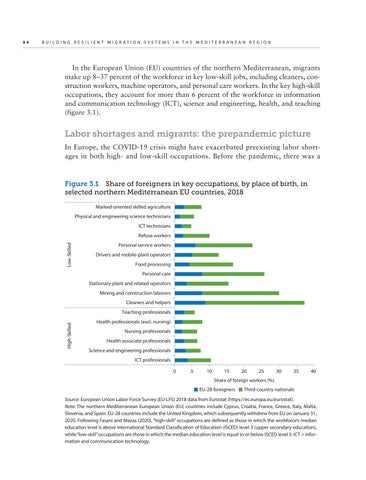B U ILDING RESILIENT MIGR A TION S Y STEMS IN T H E MEDITERR A NE A N REGION
In the European Union (EU) countries of the northern Mediterranean, migrants make up 8–37 percent of the workforce in key low-skill jobs, including cleaners, construction workers, machine operators, and personal care workers. In the key high-skill occupations, they account for more than 6 percent of the workforce in information and communication technology (ICT), science and engineering, health, and teaching (figure 3.1).
Labor shortages and migrants: the prepandemic picture In Europe, the COVID-19 crisis might have exacerbated preexisting labor shortages in both high- and low-skill occupations. Before the pandemic, there was a
Figure 3.1 Share of foreigners in key occupations, by place of birth, in selected northern Mediterranean EU countries, 2018 Marked-oriented skilled agriculture Physical and engineering science technicians ICT technicians
Low-Skilled
Refuse workers Personal service workers Drivers and mobile-plant operators Food processing Personal care Stationary-plant and related operators Mining and construction laborers Cleaners and helpers Teaching professionals High-Skilled
94
Health professionals (excl. nursing) Nursing professionals Health associate professionals Science and engineering professionals ICT professionals 0
5
10
15
20
25
30
35
40
Share of foreign workers (%) EU-28 foreigners
Third-country nationals
Source: European Union Labor Force Survey (EU-LFS) 2018 data from Eurostat (https://ec.europa.eu/eurostat). Note: The northern Mediterranean European Union (EU) countries include Cyprus, Croatia, France, Greece, Italy, Malta, Slovenia, and Spain. EU-28 countries include the United Kingdom, which subsequently withdrew from EU on January 31, 2020. Following Fasani and Mazza (2020), “high-skill” occupations are defined as those in which the workforce’s median education level is above International Standard Classification of Education (ISCED) level 3 (upper secondary education), while “low-skill” occupations are those in which the median education level is equal to or below ISCED level 3. ICT = information and communication technology.

